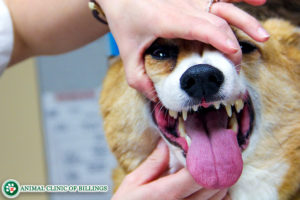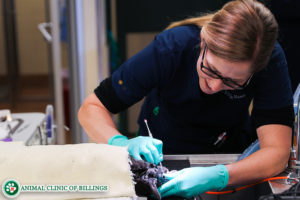Pet Dental Care
Dental Care and Tooth Removal For Your Pet
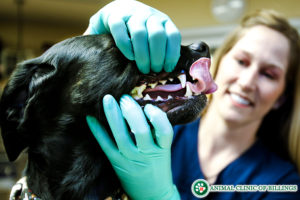 Did you know that oral health has a significant impact on your pet’s quality of life, comfort, and even lifespan? Periodontal disease is the most common clinical condition found in adult cats and dogs, and according to the American Veterinary Medical Association (AVMA), 85% of dogs and cats are affected by three years of age! For those reasons, regular pet dental care is imperative.
Did you know that oral health has a significant impact on your pet’s quality of life, comfort, and even lifespan? Periodontal disease is the most common clinical condition found in adult cats and dogs, and according to the American Veterinary Medical Association (AVMA), 85% of dogs and cats are affected by three years of age! For those reasons, regular pet dental care is imperative.
Being a responsible pet parent means doing everything in your power to keep anything harmful from impacting your pet. In a world where many diseases are not avoidable, it is particularly important to do all we can to avert those diseases that can be prevented. Our veterinarians want what’s best for you and your pet, and we love to educate clients on preventive measures to keep your pet from developing dental or periodontal disease.
The key to successful prevention is working together proactively to maintain oral health. Your pet needs a professional oral evaluation and prophylactic cleaning every 6-12 months in conjunction with a home oral health care plan.
Pets that do not receive periodic professional teeth cleanings from a vet are far more likely to develop serious conditions in the future that can quickly end up costing their owner far more than years of preventive care. Our veterinarians see examples of this all the time, which is why we can’t emphasize enough the importance of preventive veterinary care, especially when it comes to dental examinations and teeth cleaning.
If you provide the recommended preventive care to your pet it will save you money and potential heartache, as well as help your best friend live the happiest and fullest life possible.
Early detection of periodontal disease is critical because it can progress quickly and result in extensive and potentially irreversible damage to a pet’s teeth, gums, and jaw bone. As periodontal disease reaches an advanced stage, it can cause severe pain and serious health problems that extend well beyond the mouth. Advanced periodontal disease allows potentially dangerous bacteria to gain access to the bloodstream and spread to other tissues throughout the body, causing serious infections in organs such as the heart, lungs, liver, and kidneys.
At the Animal Clinic of Billings, we offer a free oral exam and, if further evaluation or a procedure is needed, we offer a discount incentive year-round to help get your pet the oral care they need and deserve!
Diagnosing dental and periodontal disease
Periodontal disease is usually difficult for pet owners to detect. While warning signs may be present, it is often challenging to pinpoint evidence of its presence without a professional examination by a veterinarian. This is because periodontal disease occurs primarily below the gum line.
Warning Signs of Dental Disease
- Bad breath
- Pawing at the face or mouth
- Difficulty chewing food
- Reddened or bleeding gums
- Tooth breakage or discoloration
When periodontal disease is detected by a veterinarian, the dog or cat then needs to be put under general anesthesia to be thoroughly examined and x-rayed. This is the only way a veterinarian can accurately evaluate both the stage and full extent of disease and determine the best treatment protocol.
What To Expect During Your Exam
During a dental examination, our veterinarians look for signs of injury and disease, including:
- Cavities
- Tooth root abscesses
- Tooth resorptive lesions (unique to cats)
- Tartar buildup (both above and below the gum line)
- Gingivitis
- Periodontal disease and infections
- Crooked or misaligned teeth causing pain or interfering with normal chewing
- Broken, infected, or devitalized teeth
- Oral masses
Following their dental exam at the Animal Clinic of Billings, our veterinarians will develop a customized plan for your pet to prevent and treat dental and periodontal disease.
Dental cleaning and treatment procedures
The use of general anesthesia is necessary to adequately perform pet dental care examinations, dental x-rays, teeth cleanings, tooth extractions, and other dental procedures. Before undergoing anesthesia, a physical exam and pre-anesthesia lab work are performed to evaluate each patient for conditions that may increase anesthetic risk. Our anesthesia medications and protocols are the safest and most reliable available, and we continually monitor your pet throughout their entire procedure and afterward until they are awake and alert.
Anesthesia makes it possible to effectively treat the oral cavity without stress and pain to the patient. It is also important for the safety of the veterinarian and staff, and enables a much more thorough cleaning, evaluation, and treatment. Cosmetic cleanings or “non-anesthetic” cleanings can actually make existing dental disease worse by roughening the enamel surface, and fail to address the most dangerous tarter, which is found under the gum line.
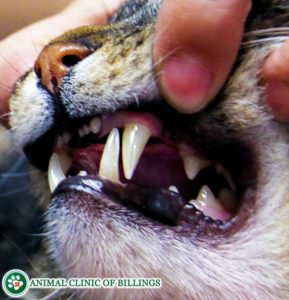 Once a pet is under anesthesia, ultrasonic and hand scaling is performed to remove tartar buildup both above and below the gum line. Thoroughly scaling below the gum line is critical to the success of any dental cleaning because bacteria-harboring tarter accumulates in the space between the gum and the tooth. Polishing the teeth after scaling smooths each tooth’s surface, making it harder for plaque to adhere to your dog’s teeth and form tartar in the future.
Once a pet is under anesthesia, ultrasonic and hand scaling is performed to remove tartar buildup both above and below the gum line. Thoroughly scaling below the gum line is critical to the success of any dental cleaning because bacteria-harboring tarter accumulates in the space between the gum and the tooth. Polishing the teeth after scaling smooths each tooth’s surface, making it harder for plaque to adhere to your dog’s teeth and form tartar in the future.
Intraoral radiographs, or X-rays, are taken to assess the status of structures below the gum line, including the tooth roots and the surrounding bone. Studies have proven that less than 50 percent of all dog and cat dental problems can be identified without dental X-rays. Full-mouth x-rays are especially important for older pets and those who have gum recession or loose teeth.
After dental X-rays are taken and reviewed by one of our veterinarians, we will provide you with the appropriate recommendations if any tooth extractions or oral surgery is needed. All oral surgery procedures and tooth extractions are performed by a veterinarian, and pre-emptive pain medication and dental nerve blocks are administered beforehand to ensure your dog or cat remains pain-free during surgery and throughout the recovery process.
Our veterinarians routinely perform the following oral surgical procedures:
- Oral mass biopsy or removal
- Removal of overgrown gum tissue
- Tooth extractions
- Crown amputations
- Tooth sealants
- Root Planing
Following your pet’s dental procedure, one of our staff members will go over any home care recommendations we have for you to promote healing and properly maintain your dog or cat’s oral health. If a potentially painful procedure was performed, we will send home pain medication and antibiotics, and will most likely advise you to feed only canned food for one to two weeks. A recheck with the veterinarian will be scheduled for 10-14 days later to ensure complete healing.
At-Home Oral Health Maintenance
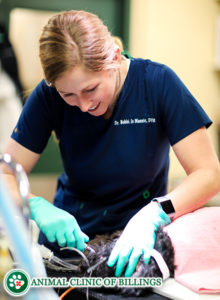
To keep the spread of disease-causing oral bacteria to a minimum, it is important that you establish regular home care involving an oral hygiene routine for your pet that may include:
- Daily tooth brushing
- Oral gels, wipes, and oral rinses
- Dental treats and chews
Your pet’s food and nutrition is also an enormous factor in your pet’s dental health, and there are food options available to help them combat dental diseases and tartar buildup. High-quality specially formulated food and treats fight tartar and plaque better than canned varieties, and selecting the best option for your pet’s individualized dental and health needs should be done with the help of your veterinarian.
Cost and quality of dental procedures
Most pet owners don’t realize how tremendously the quality of dental services vary from one veterinary hospital to another. Canine and feline dentistry at the Animal Clinic of Billings has evolved over the years, and the overall impact that dental diseases can have on the well-being and comfort of our pets.
It’s important to remember that because every veterinary clinic or hospital offers a different scope and quality of dental care, there is significant variation in the cost of dental care from one facility to another. Keep in mind that these differences in the fees charged for dental services usually reflect significant differences in the quality and comprehensiveness of the services provided.
For example, some clinics may reduce their fees by skipping pre-anesthesia lab tests, not using monitoring equipment to track your pet’s vitals, not taking x-rays, or not providing local anesthetic nerve blocks to maintain comfort following extractions. At the Animal Clinic of Billings, our veterinarians and technicians never take short-cuts, rather, they work to provide the safest and best possible dental care for your pet.
DOES YOUR DOG HAVE A HEALTHY MOUTH?
Did you know that oral health has a significant impact on your pet’s quality of life, comfort, and even lifespan? February is Pet Dental Health Month, and it’s the perfect time to ensure that your loyal companion’s mouth and teeth are in peak condition. After all, your four-legged friend’s overall well-being depends on it!
Expect that your pet will need a professional oral evaluation and prophylaxis every 6-12 months by your veterinarian in addition to your home oral care plan.
At the Animal Clinic of Billings, we offer a free oral exam and, if further evaluation or a procedure is needed, we offer a discount incentive year-round to help get your pet the oral care they need and deserve!
WHAT DO VETERINARIANS LOOK FOR IN DOGS DURING A DENTAL EXAMINATION?
Veterinarians look for disease and signs of abnormality during a dental examination on a dog.
This includes:
- Facial swelling
- Cavities
- Tooth abscesses
- Tartar buildup
- Periodontal disease
- Crooked teeth or teeth that interfere with one another
- Gingivitis
- Broken teeth
- Oral masses
At the Animal Clinic of Billings and Animal Surgery Clinic, our veterinarians will develop a customized plan just for your dog to address dental disease prevention, and if needed, dental treatment.
WHAT IS PERIODONTAL DISEASE IN DOGS?
Periodontal disease is the most common clinical condition found in adult cats and dogs, and according to the American Veterinary Medical Association, 85% of dogs and cats are affected by three years of age! Periodontal disease is usually difficult for pet owners to detect. Other than bad breath, it’s challenging to pinpoint evidence of its presence without a professional examination by a veterinarian.
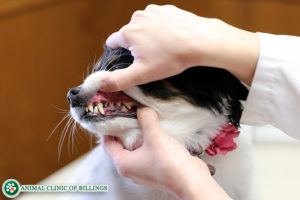
Early detection of periodontal disease is critical because it can develop quickly and result in extensive and potentially irreversible damage to a dog’s teeth, gums, and jaw bone. As periodontal disease reaches an advanced stage, it can cause severe pain and serious health problems that extend well beyond the mouth.
With advancing periodontal disease, potentially dangerous bacteria gain access to the blood supply below the gum line and can seed other tissues throughout the body, potentially causing serious infections in organs such as the heart, lungs, liver, and kidneys, among others. Untreated periodontal disease can also lead to tooth decay, tooth loss, resorption of the jaw bone, and fractures of the jaw.
Now want the good news? Periodontal disease is entirely preventable!
All you have to do to keep your dog free from pain and the perils of periodontal disease is schedule regular semi-annual dental examinations and teeth cleaning appointments with one of our veterinary dentists at the Animal Clinic of Billings and Animal Surgery Clinic. In maintaining proper oral health and hygiene for your canine companion, you are ensuring they don’t have to suffer in silence the severe pain that accompanies periodontal disease or any of the potential health risks that come with it.
WARNING SIGNS AND SYMPTOMS OF DOG DENTAL ISSUES
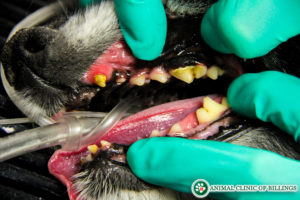
Being a responsible pet parent means doing everything in your power to keep anything harmful from impacting your pet. In a world where many diseases are unfortunately not preventable, it is particularly important to do all we can to avert those diseases that are preventable.
As with most conditions in veterinary medicine, the best and most affordable way to approach medical problems in dogs is, whenever possible, by preventing them from ever happening in the first place. Our veterinarians want what’s best for you and your dog, and we love to educate clients on preventive measures to keep your dog from developing periodontal or any other dental disease. The key to this is working together and being proactive in maintaining oral health.
The importance of proper preventive health care initiatives for pets cannot be stressed enough. Dogs that do not receive periodic professional teeth cleanings from a veterinarian are far more likely to develop serious conditions in the future that can quickly end up costing their owner far more than the cost of years of preventive care.
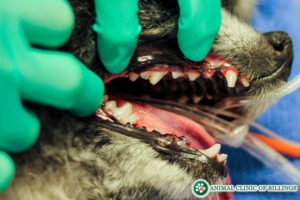
Our veterinarians see examples of this all the time, and it’s why we can’t emphasize enough the importance of preventive veterinary care, especially when it comes to dental examinations and teeth cleaning. If you provide the basic health and maintenance requirements to care for your dog in the short-term properly, it will likely save you money, and potential heartache, in the long-term, as well as help your best friend live the happiest and fullest life they possibly can.
Like humans, pets that lack proper oral and dental hygiene can develop illnesses such as gingivitis and periodontitis. If your pet displays symptoms such as foul-smelling breath, pawing at mouth area, difficulty chewing food, reddened gums, tooth discoloration, or has been more than a year since a regular vet check-up, contact your veterinarian.
What does it mean if my dog has really bad breath?
When a dog has bad breath, it typically means there is an abundance of harmful bacteria living in and around the dog’s periodontal tissues, causing chronic infection and disease inside your dog’s mouth. Some people mistakenly believe that bad breath can be normal in some breeds, but this is not the case. The presence of bad breath is never normal or healthy.
Dogs have certainly done their part to contribute to misconceptions regarding the cause of foul-smelling breath through their habits of eating feces and dead carcasses, drinking from the toilet, and orally grooming body parts we consider unsanitary. However, these practices alone are not the sole or even primary source of bad breath.
Bad breath in dogs is the result of one thing and one thing only: the presence of progressive dental disease that will continue to get worse without proper dental care. The only way to solve any progressive dental disease is by a thorough veterinary dental cleaning and implementation of a proper home care dental plan.
How do I prevent tooth and gum disease in my dog?
To keep the spread of disease-causing oral bacteria to a minimum, it is important that you establish regular home care involving an oral hygiene routine for your pet that includes:
- Regular veterinary dental exams
- Daily brushing and oral rinses
- Dental treats, health chews and diets
- Use of dentifrices, gels, wipes or water additives
FLIP A LIP!
We recommend you flip your pet’s lips routinely to check their gums and teeth, paying particular attention to the back of the mouth. Even if you don’t notice any abnormalities, you should never underestimate the importance of regular check-ups with your veterinarian.
Remember, your pet needs and deserves regular dental care, which is why we offer free oral exams to new clients. Please come see us and take advantage of this offer by letting our veterinarians examine your pet. We recommend that all dogs get checked for dental problems and get their teeth cleaned at least once a year.
If your dog displays any of the following symptoms listed below, he or she may already have serious dental disease, and you should schedule an appointment with your veterinarian immediately:
- Bad breath (halitosis)
- Difficulty eating or chewing food
- Loss of appetite
- Red, swollen, bleeding gums (often surrounding the back molars)
- Discolored or missing teeth
- Broken or loose teeth
- Nasal discharge or bloody saliva
- Swelling around the face or mouth
- Lesions or open sores in the mouth
- Extra teeth or the overcrowding of teeth
- Retained baby teeth in adults or misaligned teeth
- Abnormal chewing, excessive drooling, or food falling from the mouth when eating
- Unexplained irritability or behavioral changes
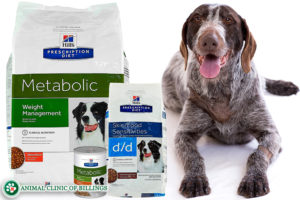 What’s the best dog food for dogs with dental health problems?
What’s the best dog food for dogs with dental health problems?
Appropriate nutrition is one of the most critically important aspects of a dog’s health and well-being. Be aware of the foods your pet is eating and ask your veterinarian if the food selection you’re feeding your dog is right for their dietary needs.
Diet is an enormous factor in your pet’s dental health, and there are food options available to help dogs combat dental diseases and tartar buildup. High-quality dry food and chew treats fight tartar and plaque better than canned varieties or leftover “people food,” and selecting the best option for your dog’s individualized dental and health needs should be done with the help of your veterinarian.
At Animal Clinic of Billings, we offer the best Hill’s and Royal Canine varieties of dog and cat food available to help keep your pet healthy. Ask us about food options, and we’ll recommend what’s best for your dog.
What if my dog has a dental disease?
A dental examination at the Animal Clinic of Billings and Animal Surgery Clinic comes as a first step and simply allows one of our veterinarians to peer inside your dog’s mouth to see if any serious dental problems are present. If our veterinarian finds any dental issues in your dog’s mouth, they will then explain to you what they see and recommend the most appropriate treatment plan.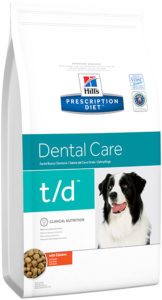
If the diagnosis is severe enough to necessitate dental surgery, your dog will be placed under general anesthesia so the veterinarian can take digital dental X-rays of the jaws and teeth, followed by a thorough examination of your dog’s mouth, including the teeth, gums, tongue, palate, cheeks, throat, and tonsils.
The veterinarian will also probe between the teeth and gums to determine the presence and degree of periodontal attachment loss from infection. All of these steps are important because more than half of each tooth is buried deep beneath the gum line, and often those are the areas most affected by dental diseases.
Many times, a tooth may look completely normal to the veterinarian upon the initial examination, but x-rays reveal that the roots are broken or abscessed below the gum line and require treatment.
Unfortunately, in these cases, the dog is most likely suffering from a significant amount of oral pain. If this is the case, and we find a significant dental problem in your dog, you can rest assured that our skilled and experienced veterinarians will make sure your dog walks away from his or her dental procedure completely free of pain and having had their periodontal disease treated as effectively as possible.
Anesthesia during dental surgery on dogs
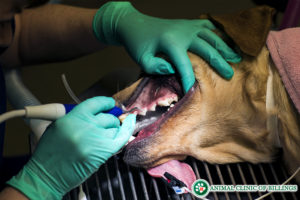
The use of general anesthesia is necessary for our veterinarians to adequately perform dental examinations, dental x-rays, teeth cleanings, tooth extractions, and other dental procedures. Before undergoing anesthesia, a physical exam and pre-anesthesia lab work are performed to evaluate each patient for conditions that may increase anesthetic risk.
Our anesthesia medications and protocols are the safest and most reliable available, and we continually monitor your dog throughout their entire procedure, and during recovery until they are awake and alert.
Once a pet is under anesthesia, ultrasonic and hand scaling is performed to remove tartar and plaque buildup above, below, and around the gum line. Thoroughly scaling below the gum line is critical to the success of any dental cleaning in dogs because tarter harboring disease-causing bacteria accumulates in the space between the gum and the tooth.
Polishing the teeth after scaling smooths each tooth’s surface, making it harder for plaque to adhere to your dog’s teeth in the future.
Your dog’s mouth is then vigorously flushed to remove dislodged tartar, plaque and bacteria.
If the veterinarian finds a diseased tooth that requires extraction, or if there’s a problem with the gums that need to be addressed, oral surgery will be recommended.
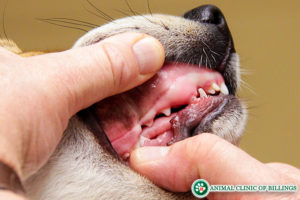
ADVANCED ORAL AND DENTAL SURGERY ON DOGS
Our veterinarians routinely provide the following oral surgical procedures:
- oral tumor removal and removal of excessive gum
- tooth extractions
- gingival surgery
- tooth sealants
The Animal Clinic of Billings and Animal Surgery Clinic is equipped to precisely perform a variety of oral surgeries so our veterinarians can help your canine companion live a healthy and happy life.
WHY DOES MY DOG NEED ANESTHESIA FOR A DENTAL CLEANING PROCEDURE?
When you go to your dentist, you understand that what is being done is meant to help keep you and your mouth healthy. Because of this, we accept the discomfort we experience while at the dentist and do our best to keep still with our mouths wide open.
Your dog, on the other hand, does not understand the benefit of a dental procedure and he or she will undoubtedly react by struggling, attempting to flee, or even biting the veterinarian if allowed to remain awake, which could easily result in injury to themselves or the veterinarian.
Anesthesia makes it possible to perform the procedure with minimal stress or discomfort for your pet and allows for a far superior cleaning and evaluation, which includes dental radiographs (x-rays) and probing below the gum line.
Cosmetic cleanings or “non-anesthetic” cleanings can actually make the existing dental disease worse and do not address periodontal disease where it occurs and where scaling is the most important: under the gum line.
PROPER DENTAL HOME CARE FOR CATS
Most cats develop dental disease at some point in their lives; in fact, by age four, more than half of cats will already have some degree of dental disease. Without intervention, dental disease is slowly progressive, and sooner or later will result in chronic pain, infection, and irreversible damage to the jaw bone and associated oral tissues.
Additionally, in the presence of periodontal disease, bacteria in the mouth are able to gain access to the bloodstream, and can establish potentially serious infections in other organs, such as the heart, lungs, liver, and kidneys. Due to these detrimental effects, as dental disease progresses, it may begin to have a significant impact not only on a cat’s quality of life, but also on their lifespan.
Dental disease in cats can be difficult for an owner to detect, as cats are usually reluctant to allow a good look in their mouths, and are adept at hiding discomfort. This is one reason an annual visit to the vet for a physical exam is so important.
There are many ways to help your cat maintain good oral health. The key is to be proactive and consistent, as it is far better to prevent dental disease from developing than it is to treat it after it is already causing problems.
Diet
Proper nutrition is the foundation for good dental health. Diets specifically designed to support oral health are available, and may be a good option for your pet.
Tooth Brushing
If possible, establish a cat tooth cleaning routine when your cat is young (talk to your vet about tips for brushing and about acclimating your cat to this procedure). Not all cats will allow you to brush their teeth, but with patience and consistency, many will become accustomed to the procedure. While daily tooth brushing is ideal, even doing it once or twice a week will have a benefit. Several different styles of specially-designed tooth brushes are available, and pet-safe toothpaste comes in multiple meaty flavors. Oral care wipes are also available as an alternative to a toothbrush and toothpaste. At The Animal Clinic of Billings, our technicians are trained to teach you how to clean your cat’s teeth at home. We will work with you to ensure the best possible home dental health routine for your cat.
Schedule wellness exams for cats at least once per year to detect dental problems in their earliest stages. Watch for signs of potential dental issues such as bad breath, difficulty chewing, or decreased interest in hard/dry foods. During a checkup with your veterinarian, be sure to mention any behaviors you’ve noticed and any concerns you have.
VETERINARY ORAL HEALTH MAINTENANCE FOR CATS
When your vet discovers signs of oral and/or dental disease on an exam, such as tarter accumulation, inflammation of the gums (gingivitis), a Feline Odontoclastic Resorptive Lesion (a focal area of enamel loss, somewhat like a cavity in a human, but usually found along the gum line), broken or loose teeth, or an oral mass, they will recommend a complete oral evaluation, cleaning, and treatment under general anesthesia.
Prior to an anesthetic dental procedure, lab work is performed to ensure that the patient does not have any detectable problems that would increase their risk of going under anesthesia. Once this is completed, the cat is given an injection of sedation (and pain medication, if a tooth extraction or other pain-inducing procedure is anticipated) to help them remain relaxed and comfortable. They are then anesthetized, and monitoring equipment is applied to continuously track the patient’s vital signs.
Patient safety is our top priority, and every patient is closely monitored throughout their procedure. Should a problem arise, it will be rapidly detected and addressed.
Once a cat is under anesthesia for their dental procedure, a technician will first scale and polish each tooth, including removal of any tarter that has built up below the gum line. The veterinarian will then closely examine each tooth and probe all the way around the gum line to detect any pockets or defects.
The vet will also examine the palate, tongue, cheeks, and throat for abnormalities. In most cases, dental x-rays will be taken to evaluate the tooth roots and surrounding bone; this is a very important step, as most dental disease actually occurs below the gum line. Once the exam and x-rays are complete, the veterinarian will treat any problems that have been found.
One dental condition unique to cats is the Feline Odontoclastic Resorptive Lesion (FORL). A FORL is somewhat like a cavity in a human tooth, in that enamel loss occurs, resulting in pain and sensitivity. These lesions tend to develop adjacent to the gum line on a cat’s premolar teeth. Treatment requires the extraction of the affected tooth.
Not all cats suffer from FORL’s, and the cause of these lesions is still under investigation. Removal of the affected tooth is curative, but cats who have one FORL are at an elevated risk of developing another in the future.
Cats should have a dental checkup annually. While you should check your cat’s teeth periodically yourself, a trained and experienced veterinarian can recognize dental problems in their earliest stages, when they are easiest to address. It is much easier to address and resolve dental issues when they are spotted early, compared to those that have advanced to cause more severe damage. We recommend a proactive approach to cat dental health.
GUM DISEASE IN CATS
Gum disease, also known as gingivitis, is the earliest form of periodontal disease (disease of the tissues around the tooth). This affect a cat’s gums, the tissues that anchor the tooth roots into the jaw bone, as well as the bone itself. Periodontal disease is caused by
infection of these tissues by bacteria that invade the space where the tooth meets the gum and gradually spread deeper into the jaw.
Periodontal disease is considered the most prevalent illness in cats over three years of age, but is also one of the most under-recognized. Although early signs of feline periodontal disease are subtle, periodic veterinary checkups every 6-12 months can be useful in helping diagnose cat gum disease before it becomes severe. Gum disease in cats is completely reversible if caught early.
CAT TOOTH EXTRACTION
There are several reasons why a cat may need to have one or more teeth extracted. Some of the most common conditions necessitating extractions include:
- Advanced periodontal disease
- Broken, infected, or devitalized teeth
- Retained baby teeth or maloccluded (misaligned) teeth
- A growth or mass involving the tissues surrounding a tooth
The complexity of a tooth extraction depends on the size and number of the tooth’s roots, as well as the health of the surrounding tissues, and may require small incisions in the gum, as well as drilling away of some of the bone surrounding the roots. General anesthesia, local anesthetic nerve blocks, and post-operative pain medications ensure that a patient stays comfortable throughout the process of extraction and healing.
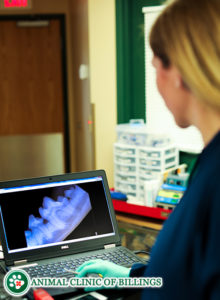 COMMON CAT DENTAL PROBLEMS
COMMON CAT DENTAL PROBLEMS
- Plaque and tarter build-up
- Gingivitis and periodontal disease
- Loose teeth and tooth loss
- Mouth sores and ulcers
- Feline Odontoclastic Resorptive Lesions (FORL)
- Oral masses
- Spread of bacteria from infected periodontal tissues to other parts of the body, such as the kidneys, liver, and heart
SYMPTOMS OF ORAL AND DENTAL DISEASE IN CATS
Cats are masters at masking symptoms of pain and illness. Bad breath is one of the few indicators of cat dental problems you are likely to observe. If your cat has noticeably lousy breath, make an appointment for a dental exam with your veterinarian.
In severe cases, you may also see the following symptoms:
- Pawing at the mouth, drooling
- Decreased appetite
- Difficulty eating or signs of discomfort while eating
- Red, swollen, and/or bleeding gums
- Loose, broken, or missing teeth
- Blood in saliva or nasal discharge
- Mouth lesions
If you notice any of these signs, your cat may have dental issues that require attention. Please schedule a veterinary appointment immediately.
ANIMAL CLINIC OF BILLINGS AND ANIMAL SURGERY CLINIC
providing our region’s companion animals and their families what they need and deserve since 1981
1414 10th St. West, Billings MT 59102
406-252-9499


